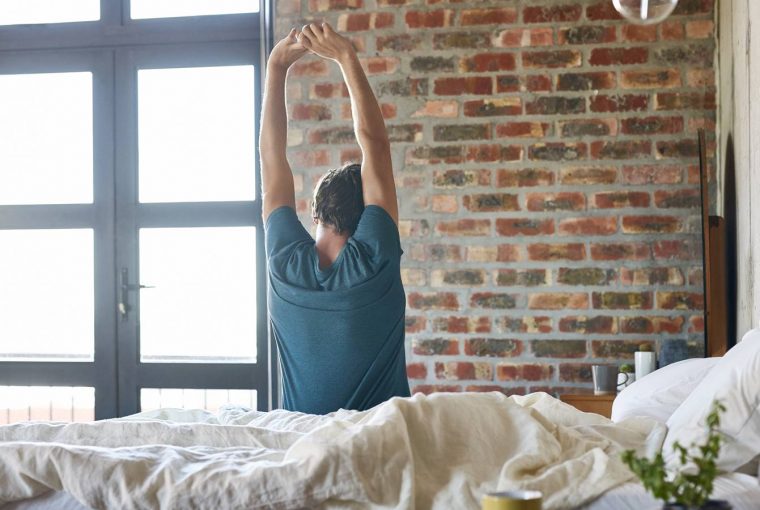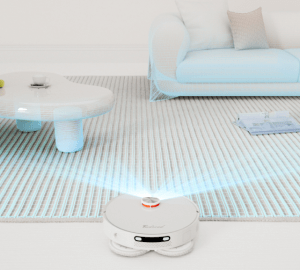By the looks of your Instagram feed, you might assume that the most restful bedtime routine includes lighting a candle, taking a bubble bath, and journaling away your worries. And while those rituals may make you feel calm and ready for some shut-eye, they’re not the only nighttime activities worth practicing. In fact, stretching before bed on the reg could do wonders for your mental and physical health, says Kimberly Washington, M.S., R.Y.T., a vinyasa yoga instructor and certified flexibility coach.
“It’s a fantastic way to book time for yourself at the end of the day and be really honest with yourself and how you’re feeling,” she says. “When you actually slow down and take time to really notice and connect, you’re going to find that it’s going to relieve a lot of anxiety and allow you to get rid of a lot of stress, just things that you’re manifesting in your body that you may or may not be aware of.”
Nighttime is also the ideal time to practice some deep stretching, which focuses on opening up the connective tissue and lengthening the tendons, she explains. ICYDK, a joint’s range of motion is influenced by the mobility of the soft tissues (e.g. muscles, ligaments, tendons) around the joint. And a lack of stretching can cause the soft tissue to shorten over time, decreasing flexibility and blood supply to cartilage and increasing the risk of muscle injury, according to U.C. Davis Health. Routinely practicing deep stretching, however, can help boost flexibility, improve balance, and increase joint stability, says Washington.
That said, “because of all that openness, you really don’t want to do deep stretching and then go for a run or go about the activities of your day,” says Washington. “Once you open the body up, it’s really best at that point to allow your body to continue to go into rest and restore.” The reason: Research shows performing static stretches for long durations before working out doesn’t help prevent injuries and substantially reduces strength and power during exercise. To ensure you get the most out of your sweat sesh, consider practicing deep stretching as one of your end-of-day — not morning — activities, she says. (FTR, you’re best off warming up with light cardio exercise to get your body ready for a workout.)
Folks who aren’t yet super flexible, though, may feel a bit of uncomfy tightness while deep stretching, which is why Washington suggests focusing on your breath while you hold each pose. Regardless of the stretch, try to exhale for twice as long as you inhale (think: breathe in four counts, then breath out for eight counts), she says. “This breathing pattern is going to help [activate] your parasympathetic nervous system [and] trigger your body to go into a rested, relaxed, restored, renewed, returned-to-calm state,” she explains. “Coming back to the breath is also going to help give you something to fixate on so that you’re not as keyed into the physical sensation.”
You’ll also want to listen to how your body feels during each stretch — and don’t ignore its warning signs. “The benefit of staying connected and following your breath [is that] you’ll be able to know if something’s too deep,” says Washington. “You’ll know, ‘Okay, I need to back out of this pose. This is a little bit too much today,’ as opposed to you powering through and not even being aware of those sort of signals your body’s kicking at you.”
One way to gauge if your before-bed stretches are too intense? Rank the intensity on a scale of one to 10, says Kiley Holliday, R.Y.T., a yoga instructor for PureYoga on Equinox+. In general, you’ll want bedtime stretches to feel like a four on that scale, she says. “You want it to feel relaxing, like something you can breathe through very easily — nothing that makes you want to clench your jaw or furrow your brow or scrunch up your toes,” she explains. “If you’re noticing those, that’s a sign that you’re probably not doing a great before-bed practice.”
If you keep in tune with your body, you might notice that you’re not able to stretch as deeply as you did a few days prior or that your stretch doesn’t match the demonstration photo to a T — and that’s okay. “It is all about exploration, trying something, and finding your truth,” says Washington. “It doesn’t have to be what you’re picturing a deep stretch would look like on an Instagram post.”
7 Before-Bed Stretches to Add to Your Nightly Routine
Ready to incorporate a stretching ritual into your bedtime routine? Consider performing a handful of these before-bed stretches for a total of 15 minutes each night. While Washington generally recommends trying each stretch for three to five minutes to fully open up the body, it may not feel feasible if you’re a stretching newbie. In those cases, try gradually working your way up to those suggested durations.
If you decide to go off the cuff with your before-bed stretches, steer clear of moves that fall into the advanced, back-bending category, such as the wheel, crescent lunge, or camel pose, suggests Holliday. “Things like that tend to wake people up a little bit,” she explains. “People should know that they can be more sensitive in terms of getting energized from those deeper stretches that expand the front side of the body and take you into a backbend.”
Above all, choose before-bed stretches that make you feel calm and at peace, says Holliday. “If something doesn’t feel relaxing or if it actually makes you feel a little bit defeated, that’s not something you would want to do before bed.”
Forward Fold
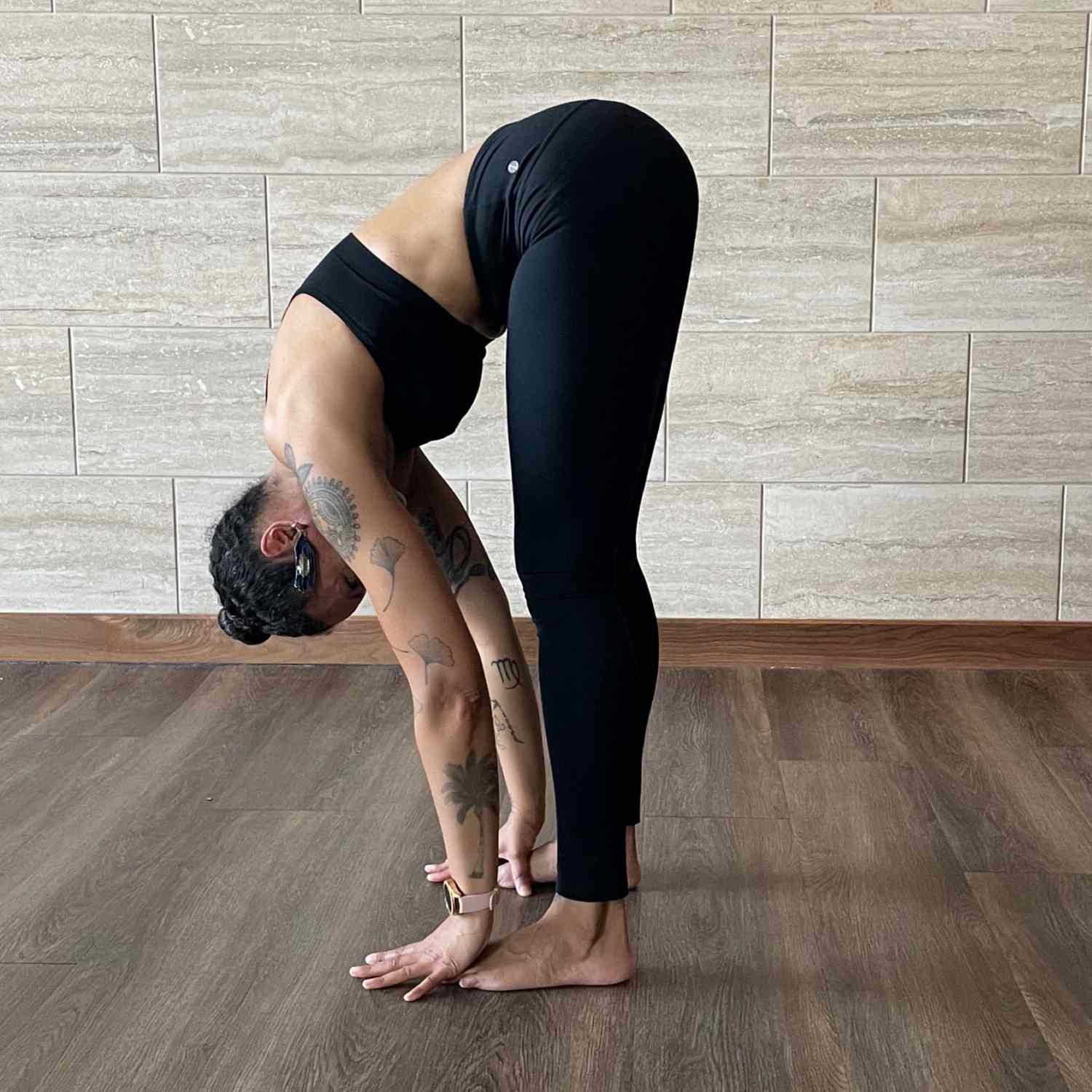
CREDIT: COURTESY OF KIMBERLY WASHINGTON / @YOGABYKIMBERLY
One of Washington’s favorites, this bedtime stretch helps lengthen the entire backside of the body. To deepen the stretch, widen your stance slightly or slightly bend your knees and allow your knuckles or fingertips to drag on the ground, she suggests.
A. Stand tall with feet hip-width apart. Hinge forward at the hips to lower into a forward fold, extending your arms as close to the floor as possible. Allow the crown of the head to reach toward the floor.
Hold for 3 to 5 minutes.
Plank
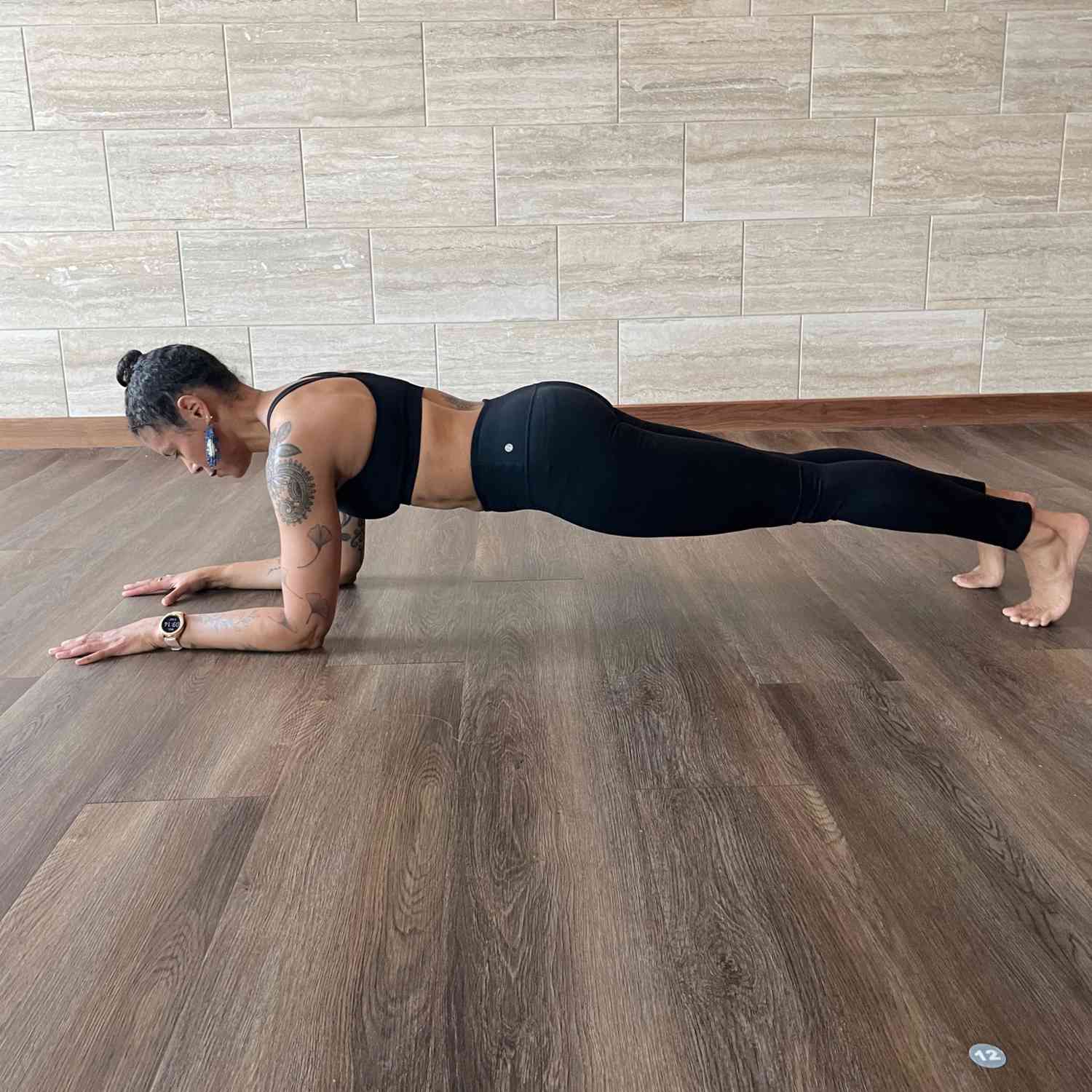
CREDIT: COURTESY OF KIMBERLY WASHINGTON / @YOGABYKIMBERLY
Surprise: A plank isn’t just a core-strengthening move, and it can be a valuable addition to your bedtime stretching routine. “[It’s] a stretch all the way through the posterior chain of the body,” says Washington. “If you’ve spent all day sort of hunched over, it feels really good to just give the body a chance to lengthen.” If a forearm plank isn’t your jam, feel free to stay in a high plank to get your stretch on.
A. Start in a high plank position. Bend elbows to the floor and rest weight on forearms. Body should form a straight line from shoulders to ankles.
B. Tuck pelvis and draw navel up toward spine to activate core. Press back into heels and keep head in line with spine.
Hold for 2 minutes.
Supine Leg Raise
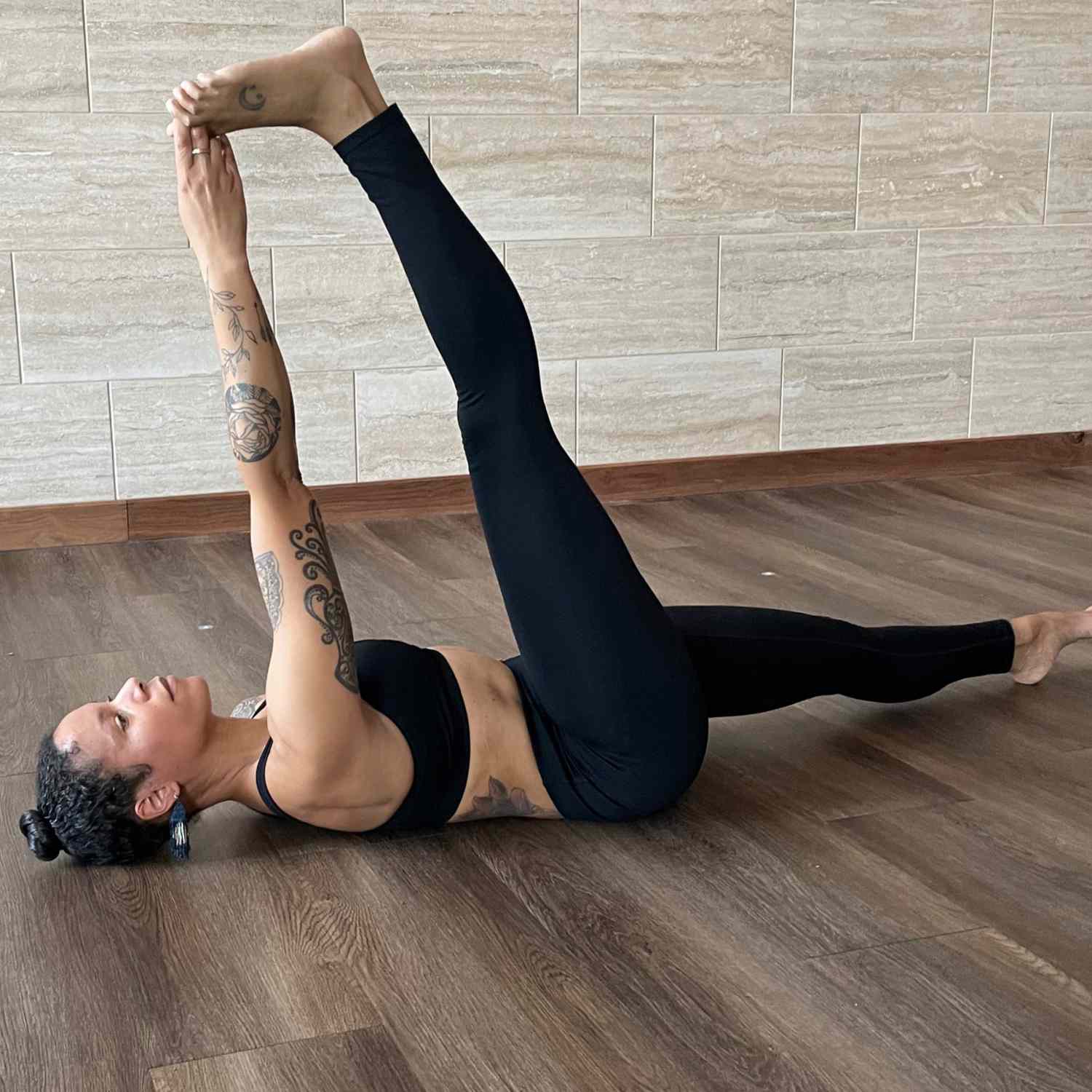
CREDIT: COURTESY OF KIMBERLY WASHINGTON / @YOGABYKIMBERLY
To modify this before-bed stretch, which lengthens the hamstrings and calves, bend one knee and plant your foot on the floor. Then, raise the opposite leg as far toward the ceiling as possible, keeping both of your arms at sides rather than reaching toward your toes, says Washington.
A. Lie on back with both legs extended in front of body and arms at sides, palms resting on floor. Raise right leg up toward the ceiling and lower it as close to chest as possible.
B. Reach toward right toes with right arm, making sure not to lift chest off floor.
Hold for 3 to 5 minutes, then repeat on the opposite side.
Lateral Hip Extension
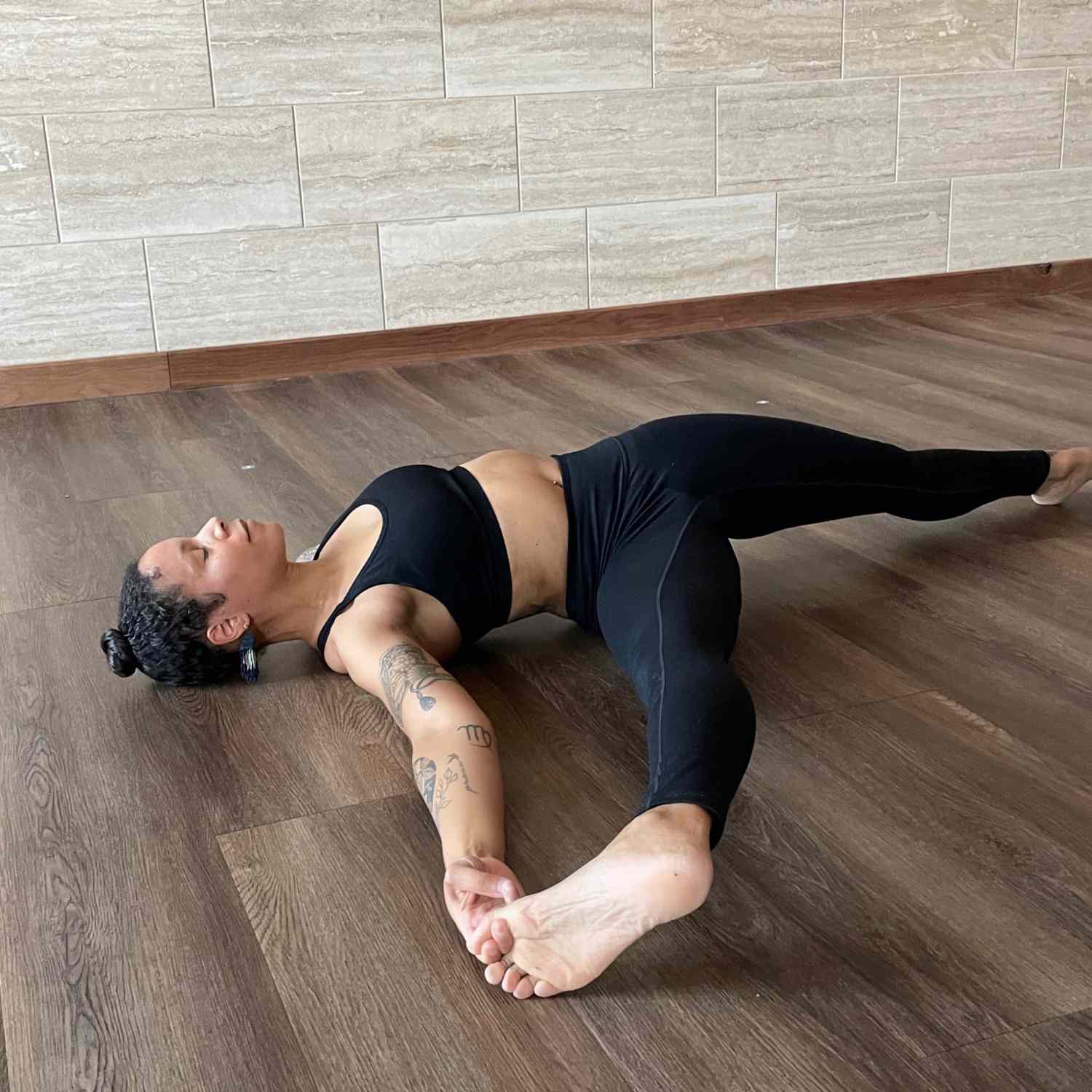
CREDIT: COURTESY OF KIMBERLY WASHINGTON / @YOGABYKIMBERLY
By lowering your leg out to your side, this variation of the supine leg raise helps open up hips and ease any tightness, says Washington.
A. Lie on back with both legs extended in front of body and arms at sides, palms resting on floor. Raise right leg up toward the ceiling and lower it as close to chest as possible.
B. Reach toward right toes with right arm, making sure not to lift chest off floor.
C. Gently lower right leg and right arm to the floor on the right side of body.
Hold for 3 to 5 minutes, then repeat on the opposite side.
Sphinx

CREDIT: COURTESY OF KIMBERLY WASHINGTON / @YOGABYKIMBERLY
This classic yoga pose is essentially a baby backbend, so you’ll feel a satisfying stretch throughout your back, says Washington.
A. Lie on stomach with chest raised, forearms extended on the floor in front of body, palms touching the floor, and legs extended behind body, with the tops of feet on the floor. Ensure elbows are positioned directly under shoulders.
B. On an inhale, pull the heart space forward and look up toward the ceiling.
Hold for 3 to 5 minutes.
Child’s Pose
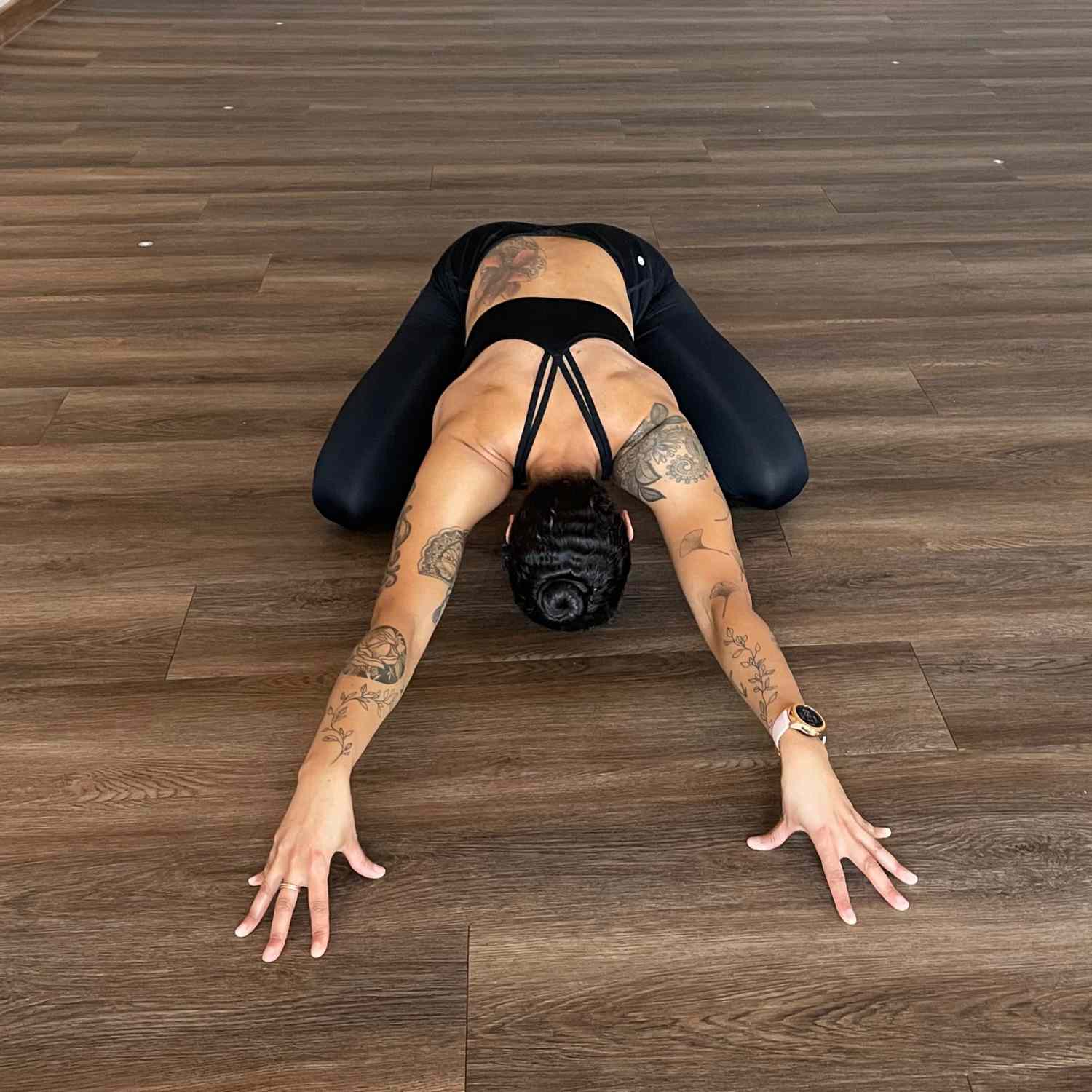
CREDIT: COURTESY OF KIMBERLY WASHINGTON / @YOGABYKIMBERLY
This before-bed stretch helps lengthen the upper back, and rotating your palms toward the ceiling can give you a stretch through the tops of the shoulders, says Washington.
A. Sit up comfortably on heels.
B. Roll torso forward, bringing forehead to rest on the mat.
C. Lower chest as close to knees as is comfortable, extending arms in front.
Hold for 3 to 5 minutes.
Pigeon
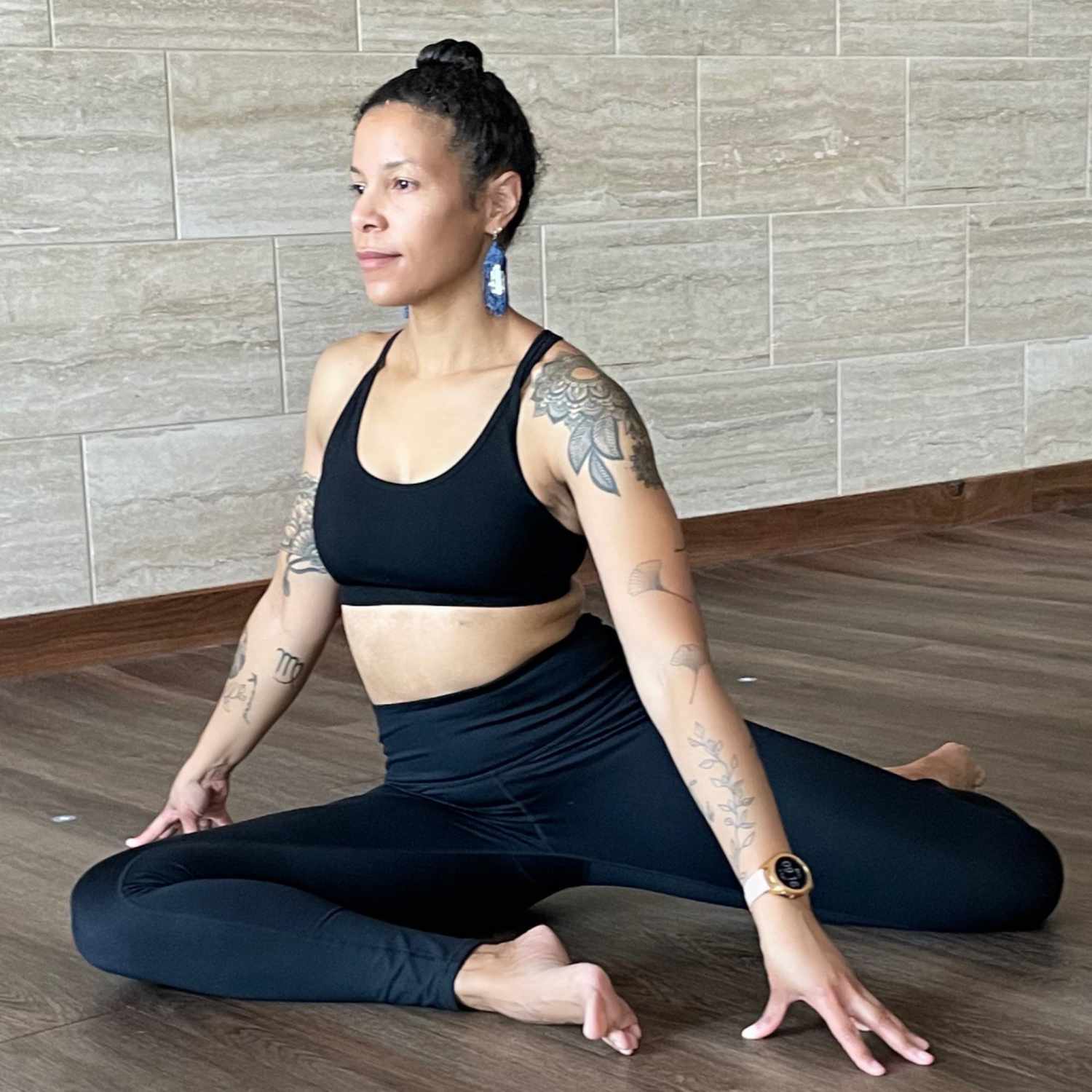
CREDIT: COURTESY OF KIMBERLY WASHINGTON / @YOGABYKIMBERLY
To open your hips after a long day of sitting in a desk chair, try this bedtime stretch. If it’s too challenging to fully extend your back leg, try bending it at a 90-degree angle (as depicted above), suggests Washington. You can also try a figure-four stretch, in which you lie on your back, cross your right ankle over your left thigh, then interlace your fingertips around the back of your left thigh and gently pull until you feel a stretch, suggests Holliday.
A. From downward dog, sweep left shin toward the front of the mat, bringing left knee behind left wrist and left ankle behind right wrist. Left shin should be parallel with the top of your mat, and keep left knee outside of left hip.
B. Gently walk right leg back as far as possible, untuck toes and press top of right foot into the floor. Slowly walk hands forward until head is on the floor or a yoga block. Draw shoulders down and away from ears.
Hold for 3 to 5 minutes, then repeat on the opposite side.

